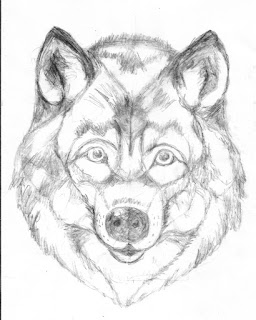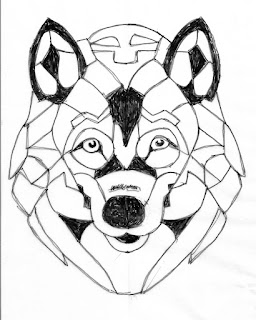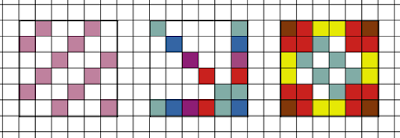| "Colorado Cougar", framed needlepoint |
I'm frequently asked about the process I follow in creating my original designs. Actually, there is no single process. Sometimes I have a clear picture in my mind when I begin. (Sometimes the finished project actually looks like that mental picture!) Sometimes a sketch generates a piece of needlework. Sometimes a piece of needlework generates a detailed drawing or painting. J.D., who is looking over my shoulder as I write, says: "Well, that ought to confuse everyone. Why don't you show them what you are talking about? I'll download the pictures." Since he keeps photographic records of much of my work in progress, that is what we are going to try to do in this post.
Last Earth Day I told him that I wanted to do a series of works featuring endangered or threatened species, beginning with those in the western United States. I had done two Close Encounters pieces by that time — a black-footed ferret with the endangered Colorado blue butterfly and the grizzly bear with the bee on her nose. I had taken a somewhat whimsical approach to those. Now I wanted to do some more serious "portraits", more like the black-maned lion that I did in honor of a rare lion and his son, both killed by trophy hunters. I began with a sketch of a wolf. This is not a particular wolf, but rather a composite of several wolves. I noticed in my research that wolves often seem to be smiling or laughing, and that's what the one I was working on wanted to do. (Many artists, if they are honest, will tell you that their work often seems to have a mind of its own; I've found it wise to let mine express themselves.) The result was "Alpha Wolf"'.
I began with the sketch you see here. I had already decided to do the "portrait" in French longstitch on a background of tent stitch, so I made a secondary sketch with areas of the longstitch blocked out. I then traced that simpler sketch onto my canvas, keeping the more detailed one for reference.
As I stitched the design, the subject continued to express his personality. I always do the eyes of a subject last. Whether I'm doing people or animals, I don't feel that i really know them until we are eye-to-eye. I decided he must be the leader of the pack, proud of his authority and the fact that he would be the father of all the future wolf pups — and happily unaware that he was only alpha male because the alpha female had chosen him. Here he is.
As you are probably aware if you read these posts regularly, we have done a number of art and craft shows the past few months. Each one is different. Sometimes J.D. and I spend most of the time discussing his photographs and my needlework with visitors. At other times there are quiet periods when nothing much seems to be happening. Then J.D. usually goes off with his camera, taking pictures of anything that interests him. I’ve learned to take a sketchbook along. If the lighting permits, which it does not always do, I work on a sketch or two. At one show I was paging through my sketchbook and came across the early wolf sketch. I had several shades of drawing pencils and charcoal pencils with me, so I decided to do a detailed finished picture from the sketch, knowing J.D. had already photographed the original sketch for future reference. This time my subject had a more serious expression, as you can see in the print which J.D. has made from my sketchbook page.
I had innocently opened a Pandora's box. J.D. wanted to go through my old sketchbooks and look for other sketches that would be suitable for prints as they were, or with considerable extra work on my part. We showed a few of the prints at a recent event. They were favorably received and the wolf print sold, so I think I have my winter's work already laid out for me. I am getting rid of a lot of paper, which is a good thing, but nothing goes into the wastebasket until J.D. says it goes!
Of the wildlife "portraits" I have completed in the new series of needlepoints, my favorite is the cougar at the top of this post. I have a great friend of my age group (yes, there are still some of us around and working!) who was doing a painting of a Florida panther — also a cougar — at the same time that I was stitching my Colorado cougar. Neither of us was aware of the other’s project. Hers was done from a clipping she had kept for many years about a female panther which was protected for many years in Florida and became quite a celebrity. I told my friend that hers was a "glamour girl", while mine was a hard-working single mother with mouths to feed.
J. D. discovered when he photographed the finished needlepoint that the cougar's eyes seemed to follow him wherever he went. I had not noticed the effect because I was working so close to her on the canvas. I recalled walking the long gallery in the Louvre, where the Mona Lisa hangs at the center, in both directions and seeing the picture's eyes always following me. So we refer to my cougar as having Mona Lisa eyes. That fascinates viewers, especially children, when we show her. They walk back and forth to see that it is really true.
After the shows ended, I returned to sketches I made of grizzlies' heads when I was working on "What Kind of Sunflower Are You?" I've made a detailed rendering of a grizzly as a companion piece for the wolf and others. J.D. wants me to let you know that he will have a number of the prints for sale in our Etsy shop (see the sidebar on this post) early in 2019 for those of you who are interested.
Let's do what we can to preserve our native wildlife wherever we are.
| "The Tiger Vanishes", original pencil/pen & ink drawing |
 This post by Annake's Garden is licensed under a Creative Commons Attribution-NonCommercial-ShareAlike 3.0 Unported License.
This post by Annake's Garden is licensed under a Creative Commons Attribution-NonCommercial-ShareAlike 3.0 Unported License.








